Instructions to candidates;
- Write your name, index number and name of your school in the spaces provided
- This paper consists of two parts A and B.
- Answer ALL questions in section A in the spaces provided
- In section B answer questions 6 (compulsory) and either question 7 or 8 in the spaces provided after question 8.
For Examiners Use Only
|
Section |
Question |
Maximum score |
Candidates score |
|
|
A |
1 |
8 |
||
|
2 |
8 |
|||
|
3 |
8 |
|||
|
4 |
8 |
|||
|
5 |
8 |
|||
|
B |
6 |
20 |
||
|
7 |
20 |
|||
|
8 |
20 |
|||
|
Total score |
80 |
|||

Questions
- The table below shows variations in the form of carbon (IV) oxide is transported in the blood at rest and during physical exercise.
Form of transport
At rest (mole/litre)
During exercise(mole/litre)
Dissolved carbon (iv) oxide
0.52
0.97
Hydrogen carbonate ions
12.34
13.68
Carbon iv oxide bound to protein
0.26
0.16
Total carbon iv oxide in plasma
13.12
14.81
pH of blood
7.42
7.09
- Explain why more carbon (IV) oxide is transported in the form of hydrogen carbonate ions.
(3mks) - Account for the high total plasma content of carbon (IV) oxide during exercise. (2mks)
- Explain how one’s involvement in the exercises affects blood pH. (2mk)
- Name the protein responsible for transport of carbon (IV) oxide in the blood. (1mk )
- Explain why more carbon (IV) oxide is transported in the form of hydrogen carbonate ions.
- The diagram below shows a section through the mammalian skin
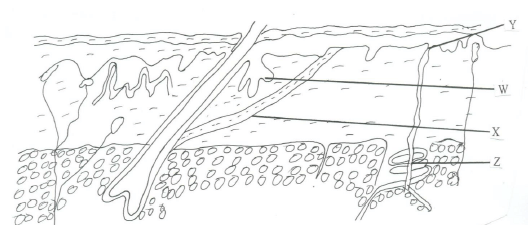
- Name the parts labelled W and X (2mks)
W………………………………………………….
X ………………………………………………… - State the function of the parts labelled Y and Z (2mks)
- Explain the changes that occur in the skin when it is cold (4mks)
- Name the parts labelled W and X (2mks)
-
- Define the term genetics (1mk)
- tufts of hair in the ear pinner is thought to be sex-linked characteristics found on the Y chromosome.
- if a man hairy ears married a woman, what is the likelihood that all their sons would have hairy ears. Show your working. (4mks)
- Name other sex-linked characteristic found in man 1mk
- Name two disoders due to non-disjunction.2mks
- The set up below was used to investigate a certain physiological process.
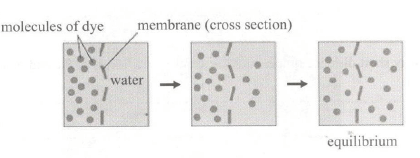
- Name the physiological process. (1mk)
- Give two examples of the process named in a) above in plants. (2mks)
- State two ways by which the movement of the dye in the set up would be slowed down. (2mks)
- What is the significance of diffusion in pollination? 1mk
- Differentiate between wall pressure and turgor pressure. 2mks
- During an ecological field work, a group of students caught 240 grasshoppers, marked them and then released them back to the study area. After one day they caught 160 grasshoppers and found that 40 were marked. Using the formula;
P =F.C.M X S.C
S.C.M
Where P =Total population
F.C.M = First capture marked
S.C = Second capture
S.C.M = Second capture marked- Work out the total population of the grasshoppers in the study area. (2mrk)
- Identify the method used to capture the grasshoppers. (1mrk)
- Name the instrument and chemical the students used to collect and mark the grasshoppers.(2mrks)
- Instrument for collection
- Chemical for marking
- State any one assumption the students made during the field work. (1mrk)
- The students observed the organisms and placed them into their correct phylum and class. Name the phylum and class.
- Phylum.................................................................................................................
- Class..........................................................................................................................
SECTION B (40MARKS)
Answer questions 6 (COMPULSORY) and Either question 7 or 8 in the spaces provided after the question 8.
- Rice seeds were soaked overnight. Fresh mass and dry mass of a sample of 20 seeds was obtained and recorded in the table. The rest of the seeds were planted in a tray that had soil and well watered daily. Twenty of the seeds/seedlings were removed from the soil every two days for two weeks. Their fresh and dry mass were taken and recorded in the table as shown below.
Time in days
Fresh mass in (g)
Dry mass in (g)
0
14.0
4.0
2
18.0
3.5
4
24.5
2.5
6
32.0
1.5
8
38.5
2.0
10
41.0
3.0
12
43.0
4.5
14
45.0
6.0
- Using the same axes, plot two graphs to represent changes in fresh and dry mass over the two –week period (7mrks)

- What would be the fresh and dry mass of the seedlings at day 9. (2mrks)
- Fresh mass
- Dry mass
- Account for the change in fresh mass and dry mass between day 0 and day 6.(4mrks)
- Fresh mass
- Dry mass
- Explain the change in dry mass from day 8 (2mrks)
- Explain why a sample of 20 seeds was used instead of one seed. (2mrks)
- State one factor within and one factor outside the seed that cause dormancy.(2mrks)
- Within the seed
- Outside the seed
- Give one characteristic of a meristematic cell (1mrk)
- Using the same axes, plot two graphs to represent changes in fresh and dry mass over the two –week period (7mrks)
-
- State three properties of enzymes. (3mks)
- Describe digestion of proteins in humans.(17mks)
-
- State four differences between mitosis and meiosis.(4mks)
- Decsribe double fertilization in flowering plants.(16mks)

MARKING SCHEME
- The table below shows variations in the form of carbon (IV) oxide is transported in the blood at rest and during physical exercise.
Form of transport
At rest (mole/litre)
During exercise(mole/litre)
Dissolved carbon (iv) oxide
0.52
0.97
Hydrogen carbonate ions
12.34
13.68
Carbon iv oxide bound to protein
0.26
0.16
Total carbon iv oxide in plasma
13.12
14.81
pH of blood
7.42
7.09
- Explain why more carbon (IV) oxide is transported in the form of hydrogen carbonate ions.3mks
- The presence of carbonic anhydrase enzyme which speeds up/ catalyzes the conversion of carbon (IV) oxide to weak carbonic acid which dissociates into hydrogen ions and hydrogen carbonate ions.
- The hydrogen carbonate ions diffuses out of the red blood cells into the blood plasma.
- Account for the high total plasma content of carbon (IV) oxide during exercise. 2mks
- There is high rate of respiration to provide more energy for exercise/ muscular activity. This releases more carbon (IV) oxide into blood plasma
- Explain how one’s involvement in the exercises affects blood pH.2mk
- The high rate of respiration during physical exercises results into production of more carbon (IV) oxide / faster accumulation of lactic acid. This lowers the pH of blood plasma/ increases acidity of blood plasma.
- Name the protein responsible for transport of carbon (IV) oxide in the blood.1mk
- Haemoglobin.
- Explain why more carbon (IV) oxide is transported in the form of hydrogen carbonate ions.3mks
-
- W---Sebaceous gland X….erector pili muscles (2mks)
- y—conducts sweat from sweat gland to the surface of the skin z—secrete and extract sweat (2mks)
- the arterioles constricts;decreasing blood flow near the body surface;discouraging heat loss;to the environment through radiation and convection.(4mks)
-
- define the term genetics 1mk
- tufts of hair in the ear pinner is thought to be sex-linked characteristics found on the Y chromosome.
- if a man hairy ears married a woman, what is the likelihood that all their sons would have hairy ears. Show your working. 4mks
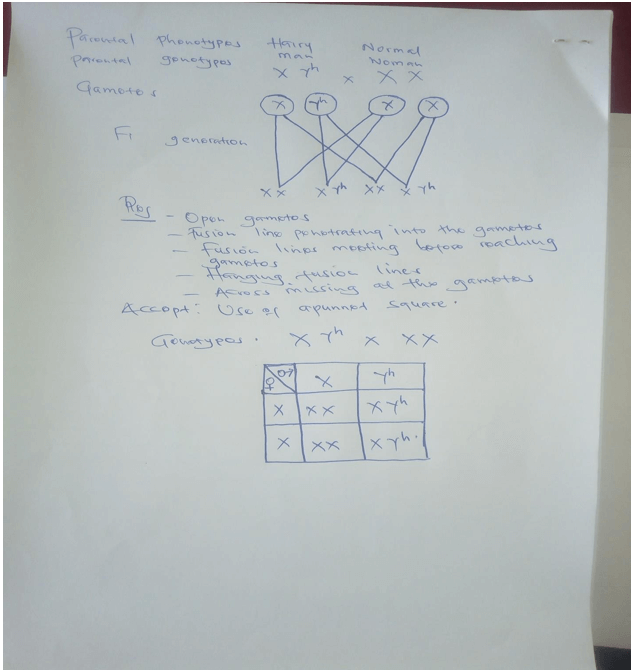
- name other sex-linked characteristic found in man 1mk
- hemophilia
- pre mature baldness
- color blindness
- if a man hairy ears married a woman, what is the likelihood that all their sons would have hairy ears. Show your working. 4mks
-
- Klinefelter’s syndrome
- turners syndrome
- down syndrome
- The set up below illustrates a certain physiological
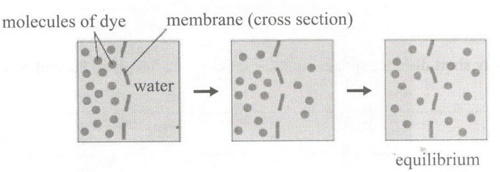
- Name the physiological process. (1mk)
- diffusion
- Give two examples of the process named in a) above in plants. (2mks)
- Gaseous exchange/ excretion of carbon (IV) oxide. Absorption/ uptake of mineral ions.
- Translocation/ transport of manufactured food.
- State two ways by which the movement of the dye in the set up would be slowed down. (2mks)
- Increasing thickness of the membrane.
- Using less dye/ adding more water/ reducing concentration gradient
- lowering temperature
- What is the significance of diffusion in pollination? 1mk
- Insects that carry out pollination are attracted by the smell from the flowers. This may lead to pollination.
- Differentiate between wall pressure and turgor pressure.
- Wall pressure is the inward pressure exerted by the cell wall on the cell membrane to resist expansion as the cell takes in water through osmosis.
- Turgor pressure is the outward pressure exerted by the expanded vacuole on the cell wall as the cell takes in water through osmosis.
- Name the physiological process. (1mk)
-
-
- P = F.C.M X S.C
S.C.M
= 240 X 160 ;
40
= 960 grasshoppers.;
- P = F.C.M X S.C
- Capture and recapture method;
-
- Sweep net
- Nail vanish/indelible ink;
-
- No migration/No movement into and out of the study area;
- There is even distribution of the grasshoppers in the study area;
- There is random distribution of the grasshoppers after the first capture;
- No birth or deaths of grasshoppers during the field study;
-
-
-
- Arthropoda;
- Insecta
Reject spelling Arthropod insect. (total 8mks)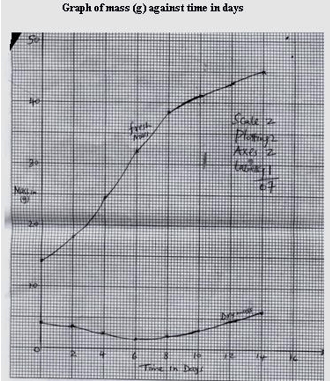
-
- 2.75g ± 0.5;
- 39.5g ± 0.5;
-
- Absorption of water hence rapid increase in mass;
- Decrease in dry mass; food stored is oxide/used in respiration to provide energy needed for germination;
- Photosynthesis occurs; Plumule and foliage leaves are developed;
- To give an average; reduces error in measurement/for accuracy.
-
- embryo maturity; germination inhibitors; lack of hormones; lack of enzymes; impermeable seed coat. Any @ 1 mark.
- water/moisture; oxygen; warmth any 1 @ 1mark.
- Thin cell walls; dense cytoplasm; no vacuoles. Any @ 1mark.
-
-
- substrate specific
- Protein in nature hence affected by change in temperature and ph Work in small quantities
- Catalyse reversible reactions
-
- The meal is ingested through the mouth;its chewed /masticated by teeth;to reduce /break into smaller particles mixed with saliva from salivary gland;the food is then rolled by the tongue into boluses and pushed down into the oesophagus/swallowed;the boluses move by peristalysis into the stomach;constant contraction and relaxation of the stomach wall mix the food;presence of food in the stomach further stimulates production of gastric juice which contains pepsinogen and renin/chymosin;pepsinogen is activated to pepsin by hydrochloric acid;pepsin breaks down proteins into peptides;renin converts /coagulates the proteins/caseinogen in milk to casein;it is then pushed into the duodenum(through pyloric sphincter);pancreatic juice in the duodenum contains trypsin (secreted in inactive form trypsinogen),which digest proteins into peptides ,in the ileum intestinal juice/succus entericus is secreted; it contains peptides enzyme/which breaks down peptides into amino acids;it also contains polypeptides enzyme which breakdown polypeptides into amino acids;completing the process of digestion of proteins,the amino acid molecules pass through the epithelial of the villi and the capillary walls/are absorbed into the blood stream;(by active transport).the undigested /indigestible proteins/food substances pass through to the colon/large intestine where water is absorbed,leaving a semi solid waste material being passed on to the rectum;then out of the body through the anus(as faeces);
- substrate specific
-
-
4mksMeiosis
Mitosis
Homologous chromosomes associate with one another
Homologous chromosomesdo not associate with one another
Takes place in two nuclear divisions/phases each having four stages
Takes place in one nuclear division/phase of four stages
Produces four daughter cells each haploid
Produces two daughter cells each diploid
Occurs in reproductive organs leading to formation of gametes
Occurs in somatic cellsleading to growth and repair
Chiasma formation takes place and may lead to variation
No chiasma formation therefore no crossing over hence no variation;
- Fertilization is the fusion of the male and female nuclei in the embryo sac; The male gamete is contained in the pollen grain; produced in the anthers; The female gamete is found in ovules; within the embryo sac; After pollination, the pollen grain absorbs nutrients from the stigma; and forms an outgrowth called the pollen tube; which grows down the style to the embryo sac taking along the male gametes with it; The pollen grains usually adhere to the stigma as a result of the stigma cells secreting a sticky substance; which also stimulates the pollen grain to germinate sending down its pollen tube; The growth of the pollen tube into the stigma, through the style to the ovary, is by pushing its way between the cells ;where it gets its nourishment from the surrounding tissues;
As the pollen grain germinates; the (pollen) tube nucleus occupies a position at the tip of the growing pollen tube; the generative nucleus divides by mitosis; into two male gamete nuclei; which follow behind the tube nucleus as the pollen tube grows down the style. The pollen tube enters an ovule through the micropyle; and when it reaches the centre of the ovule it penetrates the wall of the embryo sac and bursts open; the(pollen) tube nucleus disintegrates leaving a clear way for the entry of the male nuclei; One of the male nuclei fuses with the (functional)egg cell nucleus; to form a diploid zygote; which develops into an embryo; while the other male nucleus fuses with the polar nuclei to form a triploid nucleus; which develops into a primary endosperm; this gives the double fertilization which is unique in flowering plants; 23max 16
-
Download Biology P2 Questions and Answers - Butula Sub-County Post Mock Exams 2021/2022.
Tap Here to Download for 50/-
Get on WhatsApp for 50/-
Why download?
- ✔ To read offline at any time.
- ✔ To Print at your convenience
- ✔ Share Easily with Friends / Students

